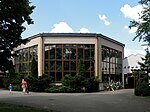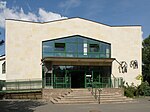| Warsaw Zoo | |
|---|---|
 Ogród Zoologiczny w Warszawie | |
    Left to right: Aviary • Hippopotamus enclosure • Elephant house • Bear enclosure | |
 | |
| 52°15′28″N 21°01′20″E / 52.25778°N 21.02222°E | |
| Date opened | 1928[1]–1939, 1948 |
| Location | Warsaw, Poland |
| Land area | 40 hectares (99 acres)[1] |
| No. of animals | 11,764 (4 November 2019)[2] |
| No. of species | 534 (4 November 2019)[2] |
| Annual visitors | 700,000 (2016)[5] |
| Memberships | EAZA,[3] WAZA[4] |
| Director | Andrzej Kruszewicz |
| Website | www |
The Warsaw Zoological Garden, known simply as the Warsaw Zoo (Polish: Miejski Ogród Zoologiczny w Warszawie), is a scientific zoo located alongside the Vistula River in Warsaw, Poland.[6] Opened in 1928, the zoo covers about 40 hectares (99 acres) in central Warsaw, and sees over 700,000 visitors annually, making it one of the most popular zoos in Poland.[7] It is home to over 11,000 animals representing more than 500 species.[8][9]
The zoo is an accredited member of the European Association of Zoos and Aquaria (EAZA) and the World Association of Zoos and Aquariums (WAZA).[10]
The Warsaw Zoo served as a hiding place for Jews and escapees from the Warsaw Ghetto during World War II.[11] Zookeepers Jan and Antonina Żabiński, responsible for saving hundreds of Jews within the zoo premises, were eventually granted the title of Righteous Among the Nations for their contribution, effort and good will. These events were documented in the novel The Zookeeper's Wife by Diane Ackerman and in the 2017 war drama film starring Jessica Chastain.[11]
- ^ a b Cite error: The named reference
zoo_mainwas invoked but never defined (see the help page). - ^ a b Cite error: The named reference
zoo_guidewas invoked but never defined (see the help page). - ^ Cite error: The named reference
eaza_listwas invoked but never defined (see the help page). - ^ Cite error: The named reference
waza_listwas invoked but never defined (see the help page). - ^ "Warszawskie ZOO podsumowuje ostatni rok i już planuje kolejne inwestycje" (in Polish). Retrieved 10 October 2022.
- ^ "Warsaw Municipal Zoological Garden (Poland): Top Tips Before You Go - TripAdvisor". Retrieved 19 November 2016.
- ^ "Warszawskie ZOO podsumowuje ostatni rok i już planuje kolejne inwestycje" (in Polish). Retrieved 10 October 2022.
- ^ "Animal species". WELCOME TO WARSAW ZOOLOGICAL GARDEN. Retrieved 8 November 2019.
- ^ "Warsaw Municipal ZOO garden". The Visitor. Retrieved 9 November 2019.
- ^ "Gorillas Land - Warsaw Zoo". Retrieved 19 November 2016.
- ^ a b "The Zookeeper's Wife: Fact vs. Fiction - Article - Culture.pl". Retrieved 29 August 2017.